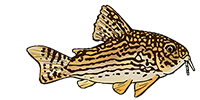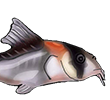Aggressive L. galaxias
-
Marc van Arc
- Expert
- Posts: 5038
- Joined: 19 Dec 2004, 14:38
- My articles: 20
- My images: 61
- My catfish: 9
- Spotted: 35
- Location 2: Eindhoven, The Netherlands
Aggressive L. galaxias
To my utter disbelieve (which soon turned into anger later on) I witnessed my new Leporacanthicus galaxias (which I swapped against my pair of L18's) is attacking anything that comes near it. Moreover, it chases other fish as well.
This looks nice when he tries to chase Exodons (no way!), but gets pretty annoying when Platystacus are almost getting crushed by the silly beast. Yesterday evening I saw it wriggling into a piece of wood which was crowded with Auchenipterids.... for a short time. One Trachelyopterus galeatus couldn't get out quickly enough however, and this poor female got badly damaged. This happened just before lights out (11.30 pm), and in a state of sheer madness I had to get some sleep. Not!
But today I'll be the hunter and despite it will upset my fish again I have to choose the worst of two evils, so I'm getting this one of the tank a.s.a.p.
Has anyone had similar experiences with this species?
This looks nice when he tries to chase Exodons (no way!), but gets pretty annoying when Platystacus are almost getting crushed by the silly beast. Yesterday evening I saw it wriggling into a piece of wood which was crowded with Auchenipterids.... for a short time. One Trachelyopterus galeatus couldn't get out quickly enough however, and this poor female got badly damaged. This happened just before lights out (11.30 pm), and in a state of sheer madness I had to get some sleep. Not!
But today I'll be the hunter and despite it will upset my fish again I have to choose the worst of two evils, so I'm getting this one of the tank a.s.a.p.
Has anyone had similar experiences with this species?
- pturley
- Posts: 833
- Joined: 08 Jul 2003, 23:11
- I've donated: $66.00!
- My articles: 2
- My images: 16
- My cats species list: 1 (i:0, k:0)
- Spotted: 8
- Location 1: Cleveland, Ohio USA
-
Marc van Arc
- Expert
- Posts: 5038
- Joined: 19 Dec 2004, 14:38
- My articles: 20
- My images: 61
- My catfish: 9
- Spotted: 35
- Location 2: Eindhoven, The Netherlands
I had 3 Leporacanthicus sp. (L263) and one of them killed the other 2 and a male L034.
He had a really bad attitude and at first I didn't realize who was doing the killings
because the fish were in a tank full of African cichlids. I soon witnessed a brutal beating
for myself and I tried to save the victim but it later died in a hospital (tank). I'm not an
expert on Loricariidae but I think it is safe to assume that Leporacanthicus species are
rather dangerous to other plecos.
He had a really bad attitude and at first I didn't realize who was doing the killings
because the fish were in a tank full of African cichlids. I soon witnessed a brutal beating
for myself and I tried to save the victim but it later died in a hospital (tank). I'm not an
expert on Loricariidae but I think it is safe to assume that Leporacanthicus species are
rather dangerous to other plecos.
-
Marc van Arc
- Expert
- Posts: 5038
- Joined: 19 Dec 2004, 14:38
- My articles: 20
- My images: 61
- My catfish: 9
- Spotted: 35
- Location 2: Eindhoven, The Netherlands
I have never seen a Leporacanthicus sp. attack another fish. We keep them, one individual per tank and never with any other bottom dwellers in the store(because of their reputation), and I have never kept any at home. What I'm interested in is how, mainly, the attack is done? Plain ramming head on? Slashing with pectoral spines or beating with the base of the tail? Maybe it´s a combination of all three... or are they in possession of some secret weapon.  Or do they actually bite other fish?
Or do they actually bite other fish?
- racoll
- Posts: 5258
- Joined: 26 Jan 2004, 12:18
- My articles: 6
- My images: 181
- My catfish: 2
- My cats species list: 2 (i:2, k:0)
- My aquaria list: 1 (i:0)
- Spotted: 238
- Location 1: London
- Location 2: UK
My L.joselimai is very placid indeed, although it's not quite sexually mature.
Only on one occasion have I seen it being aggressive. Just after a water change it wanted to get into a cave inhabited by a male Hypancistrus L262.
The L.joselimai gnawed at it's back and flank for about 5 minutes solid. The L262 finally relinquished it's home, and suffered only light scarring, which is surprising considering the teeth they possess.
Here's a great pic from the Armbruster website....

Only on one occasion have I seen it being aggressive. Just after a water change it wanted to get into a cave inhabited by a male Hypancistrus L262.
The L.joselimai gnawed at it's back and flank for about 5 minutes solid. The L262 finally relinquished it's home, and suffered only light scarring, which is surprising considering the teeth they possess.
Here's a great pic from the Armbruster website....

-
Marc van Arc
- Expert
- Posts: 5038
- Joined: 19 Dec 2004, 14:38
- My articles: 20
- My images: 61
- My catfish: 9
- Spotted: 35
- Location 2: Eindhoven, The Netherlands
I saw the first two being done; it also uses it's whole body (not just the tail) to squeeze other fish against wood or tank windows.TalenT wrote:Plain ramming head on? Slashing with pectoral spines or beating with the base of the tail? Maybe it´s a combination of all three
No, or it should be their ill-minded characterTalenT wrote: or are they in possession of some secret weapon
Yes!TalenT wrote: Or do they actually bite other fish?
I can only tell you what I saw with Leporacanthicus sp. (L263). My killer pleco used
it's mouth to completely destroy it's rival. There was also some pushing and wrestling.
He (or she) chewed up a total of 4 plecos and I was able to save only one female L034
and all the rest died later from their injuries.

it's mouth to completely destroy it's rival. There was also some pushing and wrestling.
He (or she) chewed up a total of 4 plecos and I was able to save only one female L034
and all the rest died later from their injuries.

- DeepFriedIctalurus
- Posts: 236
- Joined: 23 Jan 2003, 04:32
- My cats species list: 11 (i:0, k:0)
- My aquaria list: 1 (i:0)
- Location 2: Saginaw River basin, US
- Interests: anything powered by an internal combustion engine, non-feathered/furred pets, anti-ignorance activism
I have to agree that they don't call them vampire plecos just for how the teeth look, they truely can inflict alot of damage with them. I used to have an L007 that was only 4" SL in my 135g tank, that little rat would shred the fins of every other bottom dweller in the there and it was the smallest of the bunch!
Only the big Botia that were in there at the time were safe, speed & clicking kept their fins intact..
To put it simply, I don't miss that fish one bit!
Only the big Botia that were in there at the time were safe, speed & clicking kept their fins intact..
To put it simply, I don't miss that fish one bit!
- pturley
- Posts: 833
- Joined: 08 Jul 2003, 23:11
- I've donated: $66.00!
- My articles: 2
- My images: 16
- My cats species list: 1 (i:0, k:0)
- Spotted: 8
- Location 1: Cleveland, Ohio USA
Marc,
The posts above are consistent with my experiences with these fish.
Aucheniperids fare particularly poorly against such well armed fish. I've found, once an adult Leporacanthicus decides it's time to enhabit a cave, they don't give up.
Despite their downfalls, they remain one of my favorite groups of Loricariids
The posts above are consistent with my experiences with these fish.
Aucheniperids fare particularly poorly against such well armed fish. I've found, once an adult Leporacanthicus decides it's time to enhabit a cave, they don't give up.
Despite their downfalls, they remain one of my favorite groups of Loricariids
Sincerely,
Paul E. Turley
Paul E. Turley
-
Marc van Arc
- Expert
- Posts: 5038
- Joined: 19 Dec 2004, 14:38
- My articles: 20
- My images: 61
- My catfish: 9
- Spotted: 35
- Location 2: Eindhoven, The Netherlands
Mine too...... in bookspturley wrote: they remain one of my favorite groups of Loricariids
Thanks for the replies everyone. Wish I had known this before; it would have saved my fish and myself a lot of unnecessary stress. They still feel very uncomfortable.
Next time I'll do some reading first. That is what I usually do, but I hadn't expected any problems with this fish.
- racoll
- Posts: 5258
- Joined: 26 Jan 2004, 12:18
- My articles: 6
- My images: 181
- My catfish: 2
- My cats species list: 2 (i:2, k:0)
- My aquaria list: 1 (i:0)
- Spotted: 238
- Location 1: London
- Location 2: UK
how close is the L263 to the L264 because i have an L264 and i have heard that they can also be agressive but i have never seen it as bad as what is being described. When i first got mine it was not very nice to my L177, chasing around and such, but they are friends now i think. they hang out under the same piece of wood when there are other places to hide.
75 gallon
12 Panda Corys
15 Lemon tetras
1 L264
2 L200
1 L134
1 L186b
1 L128
1 L129
1 L81
1 L270
45 plwood tank
15 L104
12 Panda Corys
15 Lemon tetras
1 L264
2 L200
1 L134
1 L186b
1 L128
1 L129
1 L81
1 L270
45 plwood tank
15 L104
-
Marc van Arc
- Expert
- Posts: 5038
- Joined: 19 Dec 2004, 14:38
- My articles: 20
- My images: 61
- My catfish: 9
- Spotted: 35
- Location 2: Eindhoven, The Netherlands
Update: I think I'll get away with one victim. The whole thing has settled down somewhat, although I definitely lost the trust of my Trachelyopterus, which won't show themselves anymore. They have all occupied one piece of wood and hopefully they don't damage eachother in this relatively narrow space.
On the other hand I see my Liosomadoras quite often these days (well, evenings) and that is nice after several months of Pythonesque behaviour: How not to be seen.
So indeed the galaxias worked as some sort of explosive
On the other hand I see my Liosomadoras quite often these days (well, evenings) and that is nice after several months of Pythonesque behaviour: How not to be seen.
So indeed the galaxias worked as some sort of explosive
-
fish fodder
- Posts: 151
- Joined: 24 Apr 2005, 20:54
- My images: 19
- My cats species list: 17 (i:0, k:0)
- My aquaria list: 1 (i:1)
- Spotted: 9
- Location 1: YORKSHIRE
-
Marc van Arc
- Expert
- Posts: 5038
- Joined: 19 Dec 2004, 14:38
- My articles: 20
- My images: 61
- My catfish: 9
- Spotted: 35
- Location 2: Eindhoven, The Netherlands




